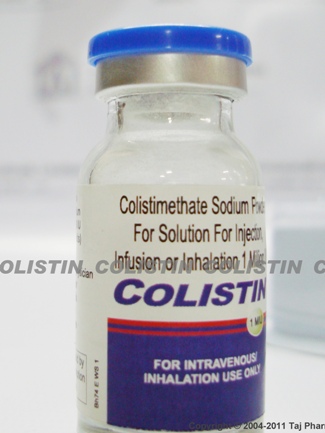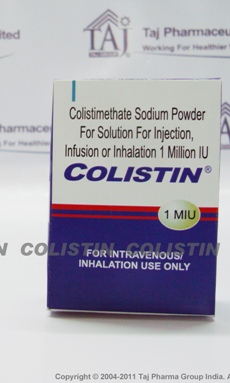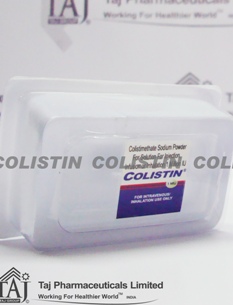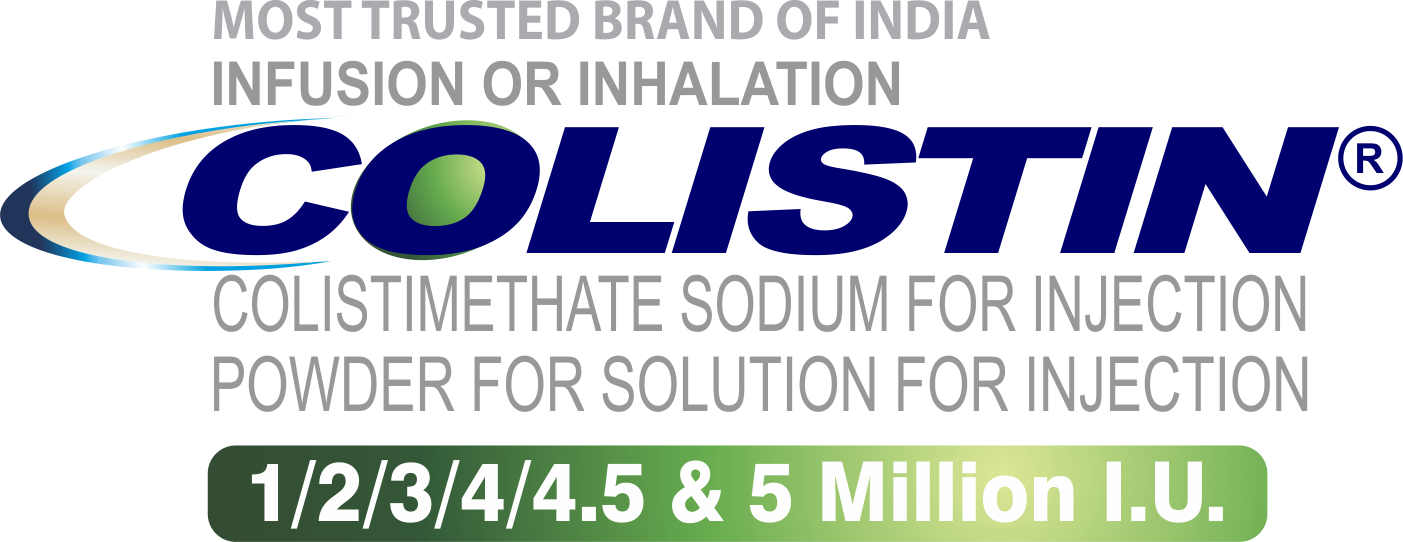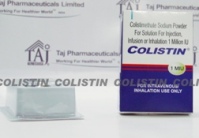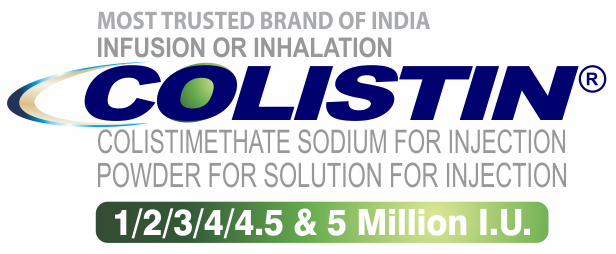|
|
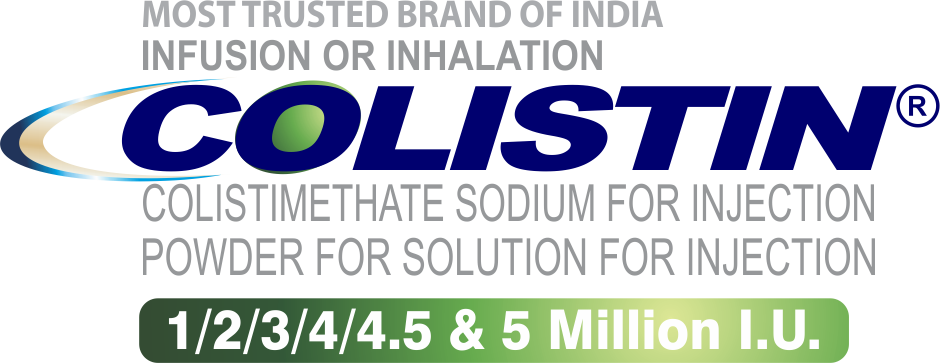
Colistimethate sodium for injection and inhalation
 (Colistin Leaflet)
(Colistin Leaflet)
Each Injection contains:
Composition:
Colistin Colistimethate sodium injection
Colistin 1 MIU
Each vial contains:
1 Million International Units (1 MIU) Colistimethate Sodium
|
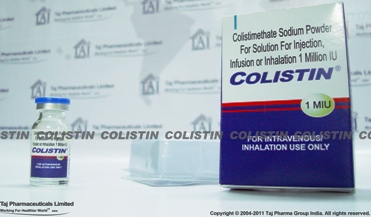 |
DOSAGE:
Powder for solution for injection, infusion and inhalation
Mode of Action: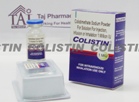
Colistimethate sodium is a cyclic polypeptide antibiotic derived
from Bacillus polymyxa var. colistinus and belongs to the
polymyxin group. The polymyxin antibiotics are cationic
surface-active agents that work by damaging the cell membrane.
The resulting physiological effects are lethal to the bacterium.
Polymyxins are selective for Gramnegative bacteria that have a
hydrophobic outer membrane.
Microbiology
Commonly susceptible species
Acinetobacter species*
Citrobacter species
Escherichia coli
Haemophilus influenzae
Pseudomonas aeruginosa
Species for which acquired resistance may be a problem
Enterobacter species
Klebsiella species
Inherently resistant organisms
Brucella species
Burkholderia cepacia and related species
Neisseria species
Proteus species
Providencia species
Serratia species
Anaerobes
All Gram-positive organisms
*In vitro results may not correlate with clinical responses in
the case of Acinetobacter species.
When necessary, expert advice should be sought when the local
prevalence of resistance is such that the utility of the agent
in at least some types of infections is questionable.
Cross-resistance
Cross-resistance between colistimethate sodium and polymyxin B
would be expected. Since the mechanism of action of the
polymyxins is different from that of other antibiotics,
resistance to colistin and polymyxin by the above mechanism
alone would not be expected to result in resistance to other
drug classes.
DOSAGE AND METHOD OF ADMINISTRATION
Systemic Treatment
Colistin can be given as a 50 mL intravenous
infusion over a period of 30 minutes. Patients with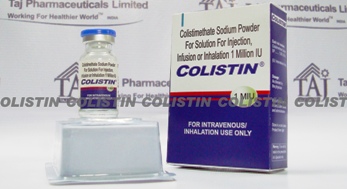 a totally implantable venous access device (TIVAD) in place may
tolerate a bolus injection of up to 2 million units in 10 mL
given over a minimum of 5 minutes (see Reconstitution for
Parenetral
Administration). The dose is determined by the severity and type
of infection and the age, weight and renal function of the
patient. Should clinical or bacteriological response be slow the
dose may be increased as indicated by the patient's condition. A
minimum of 5 days treatment is generally recommended. For the
treatment of respiratory exacerbations in cystic fibrosis
patients, treatment should be continued for up to 12 days.
a totally implantable venous access device (TIVAD) in place may
tolerate a bolus injection of up to 2 million units in 10 mL
given over a minimum of 5 minutes (see Reconstitution for
Parenetral
Administration). The dose is determined by the severity and type
of infection and the age, weight and renal function of the
patient. Should clinical or bacteriological response be slow the
dose may be increased as indicated by the patient's condition. A
minimum of 5 days treatment is generally recommended. For the
treatment of respiratory exacerbations in cystic fibrosis
patients, treatment should be continued for up to 12 days.
CONTRAINDICATIONS
Colistin is contraindicated in patients with known
hypersensitivity to colistimethate sodium (colistin) or to
polymyxin B and in patients with myasthenia gravis.
WARNINGS AND PRECAUTIONS
Use with extreme caution in patients with porphyria.
Nephrotoxicity or neurotoxicity may occur if the recommended
parenteral dose isexceeded. Use with caution in renal impairment
(see DOSAGE AND METHOD OF ADMINISTRATION) as colistimethate
sodium is renally excreted. It is advisable to assess baseline
renal function and to monitor during treatment. Serum
colistimethate sodium concentrations should be monitored.
Bronchospasm may occur on inhalation of antibiotics. This may be
prevented or treated with appropriate use of beta2-agonists. If
troublesome, treatment should be withdrawn.
PACKAGING INFORMATION
Colistin 1,2,3,4,4.5, & 5 MIU is available in vial of 10 mL
Drug Interactions
Concomitant use of colistimethate sodium with other medicinal
products of neurotoxic and/or nephrotoxic potential should be
avoided. These include the aminoglycoside antibiotics such as
gentamicin, amikacin, netilmicin and tobramycin. There may be an
increased risk of nephrotoxicity if given concomitantly with
cephalosporin antibiotics. Neuromuscular blocking drugs and
ether should be used with extreme caution in patients receiving
colistimethate sodium. Renal Impairment Use with caution in
renal impairment as colistimethate sodium is renally excreted
and please refer under DOSAGE AND METHOD OF ADMINISTRATION.
Pregnancy
There are no adequate data on the use of colistimethate sodium in
pregnant women. Single dose studies in human pregnancy show that
colistimethate sodium crosses the placental barrier and hence
should be used during pregnancy only if the potential benefit
justifies the potential risk to the foetus.
Lactation
Colistimethate sodium is secreted in breast milk. Colistimethate
sodium should be administered to breastfeeding women only when
clearly needed.
Paediatric Use
Please refer under PHARMACOKINETICS AND DOSAGE AND METHOD OF
ADMINISTRATION.
Geriatric Use
Elderly patients are more likely to have decreased renal
function, hence care should be
taken in dose selection and it may be useful to monitor renal
function.
UNDESIRABLE EFFECTS
Systemic Treatment
The likelihood of adverse events may be related to the age,
renal function and
condition of the patient. In cystic fibrosis patients,
neurological events have been reported in up to 27% of patients.
These are generally mild and resolve during or shortly after
treatment. Neurotoxicity may be associated with overdose,
failure to reduce the dose in patients with renal insufficiency
and concomitant use of either neuromuscular blocking drugs or
other drugs with similar neurological effects. Reducing the dose
may alleviate symptoms. Effects may include apnoea, transient
sensory disturbances (such as facial paraesthesia and vertigo)
and, rarely, vasomotor instability, slurred speech, visual
disturbances, confusion, or psychosis. Adverse effects on renal
function have been reported, usually following use of higher
than recommended doses in patients with normal renal function,
or failure to reduce the dosage in patients with renal
impairment, or during concomitant use of other nephrotoxic
drugs. The effects are usually reversible on discontinuation of
therapy. In cystic fibrosis patients treated within the
recommended dosage limits, nephrotoxicity appears to be rare
(less than 1%). In seriously ill, hospitalized, non-cystic
fibrosis patients, signs of nephrotoxicity have been reported in
approximately 20% of patients. Hypersensitivity reactions,
including skin rash and drug fever, have been reported. If these
occur, treatment should be withdrawn. Local irritation at the
site of injection may occur.
Inhalation Treatment
Inhalation may induce coughing or bronchospasm. Sore throat or
mouth has been reported and may be due to Candida albicans
infection or hypersensitivity. Skin rash may also indicate
hypersensitivity; if this occurs, treatment should be withdrawn.
OVERDOSAGE
Overdose can result in neuromuscular blockade that can lead to
muscular weakness, apnoea, and possible respiratory arrest.
Overdose can also cause acute renal failure characterized by
decreased urine output and increased serum concentrations of BUN
and creatinine. There is no specific antidote, so overdose
should be managed by supportive treatment. Measures to increase
the rate of elimination of colistin, e.g., mannitol diuresis,
prolonged haemodialysis or peritoneal dialysis may be tried, but
effectiveness is unknown.
INCOMPATIBILITIES
Mixing drugs in infusions, injections and nebulizer solutions
involving colistimethate
sodium should be avoided. The addition of other antibiotics such
as erythromycin, tetracycline, and cephalothin to solutions of
Colistin may lead to precipitation.
STORAGE AND HANDLING INSTRUCTIONS
Before opening:
Do not store above 25°C. Keep the vials in the outer carton.
Reconstituted solutions:
Solutions for infusion or injection
Chemical and physical in-use stability for 28 days at 4oC has been
demonstrated. From a microbiological point of view, solutions
should be used immediately. If not used immediately in-use
storage times and conditions prior to use are the responsibility
of the user. They would normally be no longer than 24 hours at 2
to 8°C, unless reconstituted and diluted under controlled and
validated aseptic conditions.
Solutions for Nebulization:
Solutions for nebulization have similar in-use stability and
should be treated as above. Patients self-treating with
nebulized antibiotic should be advised to use solutions
immediately after preparation. If this is not possible,
solutions should not be stored for longer than 24hrs in a
refrigerator.

|










